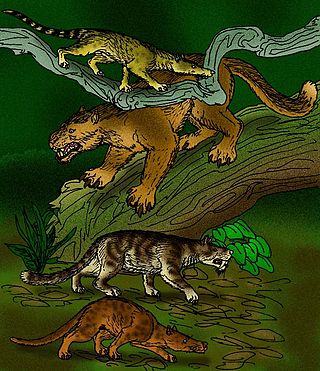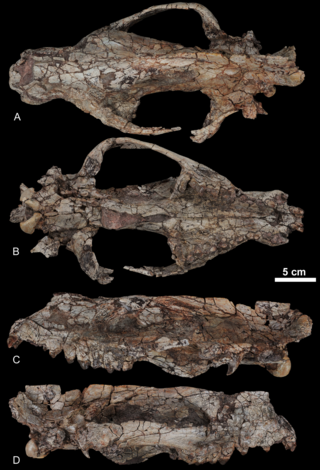
Creodonta is a former order of extinct carnivorous placental mammals that lived from the early Paleocene to the late Miocene epochs in North America, Europe, Asia and Africa. Originally thought to be a single group of animals ancestral to the modern Carnivora, this order is now usually considered a polyphyletic assemblage of two different groups, the oxyaenids and the hyaenodonts, not a natural group. Oxyaenids are first known from the Palaeocene of North America, while hyaenodonts hail from the Palaeocene of Africa.

Carnivoramorpha is a clade of placental mammals of clade Pan-Carnivora from mirorder Ferae, that includes the modern order Carnivora and its extinct stem-relatives.

Tritemnodon was an extinct genus of placental mammals from extinct order Hyaenodonta, that lived in North America during the early Eocene. Fossils of Tritemnodon agilis have been found in Utah and Wyoming. It was the size of a wolf.

Sinopa is an extinct genus of placental mammals from extinct family Sinopidae within extinct order Hyaenodonta, that lived in North America and Asia from the early to middle Eocene.

Lesmesodon is an extinct genus of placental mammals from extinct family Proviverridae within extinct superfamily Hyaenodontoidea, that lived during the Early to Middle Eocene. It was found in France and in the Messel Pit in Germany. Lesmesodon was a weasel-sized carnivorous mammal.

Hyainailouros ("hyena-cat") is an extinct polyphyletic genus of hyaenodont belonging to the family Hyainailouridae that lived during the early to middle Miocene, of which there were at least three species spread across Europe, Africa, and Asia.

Apterodon is an extinct genus of hyaenodontid mammals that lived from the late Eocene through the middle Oligocene epoch in Africa and Europe. It is closely related to the African Quasiapterodon, and together it, they comprise the hyainailurid subfamily Apterodontinae.

Galecyon ("polecat-dog") is an extinct genus of placental mammals from extinct order Hyaenodonta, that lived in Europe and North America during the early Eocene.

Hyaenodonta is an extinct order of hypercarnivorous placental mammals of clade Pan-Carnivora from mirorder Ferae. Hyaenodonts were important mammalian predators that arose during the early Paleocene in Europe and persisted well into the late Miocene.

Hyainailouridae ("hyena-cats") is a family of extinct predatory mammals within the superfamily Hyainailouroidea within extinct order Hyaenodonta. Hyaenodontids arose during the middle Eocene and persisted well into the middle Miocene. Fossils of this group have been found in Asia, Africa, North America and Europe.

Teratodontinae is a subfamily of extinct hyaenodonts. Fossil remains of these mammals are known from Middle Eocene to Late Miocene deposits in Africa, the Arabian Peninsula, and Asia.

Eurotherium is an extinct paraphyletic genus of placental mammals from extinct family Hyaenodontidae that lived from the early to middle Eocene in Europe.

Kerberos ("Cerberus") is an extinct genus of hyainailourid hyaenodonts in the subfamily Hyainailourinae, that lived in Europe. It contains the single species Kerberos langebadreae.

Limnocyoninae is a subfamily of extinct predatory mammals from extinct order Hyaenodonta. Fossil remains of these mammals are known from late Paleocene to late Eocene deposits in North America and Asia. Limnocyonines had only two molars in the upper and lower dentition.

Proviverrinae is an extinct subfamily of placental mammals within the extinct order Hyaenodonta. Fossil remains of these mammals are known from early to late Eocene deposits in Europe.
Indohyaenodontidae is an extinct family of placental mammals from extinct order Hyaenodonta. Fossil remains of these mammals are known from early to late Eocene deposits in Asia.

Dissopsalini is an extinct tribe of teratodontid hyaenodonts. Fossil remains of these mammals are known from early to late Miocene deposits in Asia and Africa.

Apterodontinae is an extinct subfamily of hyainailourid hyaenodonts that lived in Africa and Europe during the late Eocene to middle Oligocene.

Hyainailourinae ("hyena-cats") is an extinct subfamily of hyainailourid hyaenodonts that lived in Africa, Asia, North America and Europe from the middle Eocene to middle Miocene. They appeared in Africa about 47.8 Ma ago and soon after spread as far as East Asia.
Furodon is an extinct genus of hyaenodont that inhabited North Africa during the Eocene epoch. It is a monotypic genus that contains the species F. crocheti.















